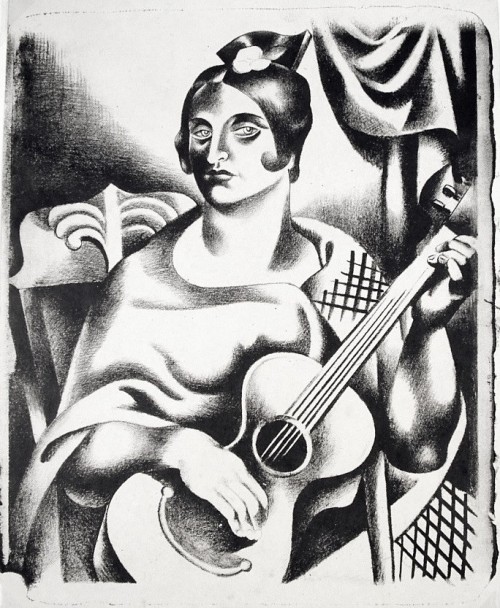Spanish Woman with Guitar

Jan Matulka (1890-1972), Spanish Woman with Guitar, lithograph, 1925, an unsigned proof impression. Reference: Flint 13, only a few impressions known. In generally good condition except for faint soiling or spotting, trimmed near the margin at left, just outside the margin right and bottom, and well above the margin (although unevenly) top. 13 3/4 x 11 5/8, the sheet 15 x 11 3/4 (approx.) inches, archival window mat.
A very good strong impression of this rarity, printed on a cream wove paper. The inky borders and irregular trimming (as well as the lack of signature) are characteristic of Matulka’s proof printing.
Born in Prague, Czechoslovakia, in 1890, Jan Matulka became a leading American modernist working at the same time as Lozowick to develop the earliest American Precisionist work, and with Stuart Davis to evolve a new form of Americanized Cubism. In 1907, he came to the Bronx, New York where he had a poverty-ridden childhood with a mother who tried to raise a family by herself. From 1908 to 1917, he studied at the National Academy of Design, and in 1917, received the first Pulitzer traveling scholarship with which he traveled and painted in the Southwest and Florida. In 1919, he first went to Paris, where he was exposed to European modernism, (especially Cubism).
Spanish Woman reflects both the realism that was always a theme in the Matulka’s work and also a Cubist idiom that he was to work with through the years. Matulka often varied his approach from rather conventional realism to cutting edge modernism, even during the same periods. Matulka had his first one-man exhibit in New York City in 1925, the year Spanish Woman was created. A reclusive and independent figure, he did not fashion his art or career for optimal art world recognition. Still, he has been the subject of great interest and regard over the years, especially among artists and curators, and his work is increasingly sought after among those interested in the evolution of American modernism.